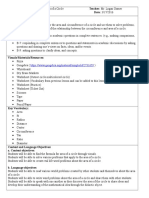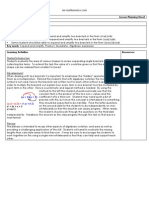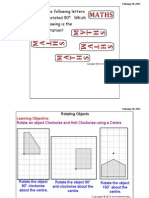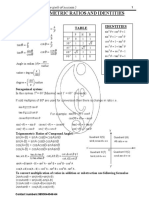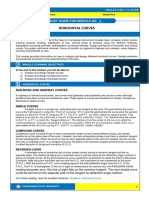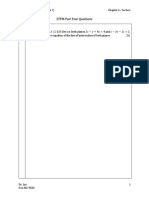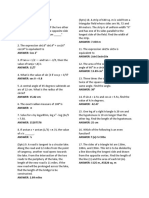Lesson Plan Circle Theorems
Lesson Plan Circle Theorems
Uploaded by
Jonathan RobinsonCopyright:
Available Formats
Lesson Plan Circle Theorems
Lesson Plan Circle Theorems
Uploaded by
Jonathan RobinsonOriginal Description:
Copyright
Available Formats
Share this document
Did you find this document useful?
Is this content inappropriate?
Copyright:
Available Formats
Lesson Plan Circle Theorems
Lesson Plan Circle Theorems
Uploaded by
Jonathan RobinsonCopyright:
Available Formats
Mr-mathematics.
com
Lesson Planning Sheet Title: Circle Theorems Learning Objectives: By the end of the lesson: All students should be able to discover the relationships between the angles at the centre and circumference of a circle, opposite angles in cyclic quadrilaterals and angles at the circumference in the same segment. Most students should be able to discover the three theorems and apply them individually to calculate missing angles. Some students should be able to discover and apply the three properties and apply them to calculate angles involving multiple theorems. Key words: Segment, Radius, Diameter, Circumference, Cyclic Quadrilateral Learning Activities Starter/Introduction Students read the text at the top of the second slide then sketch their interpretation of the instructions on mini-whiteboards. This will enable the teacher to asses the students understanding of the vocabulary so that feedback can be given. Move on to the exemplar diagrams when appropriate so that students have a clearer idea. It is important that the students construct and measure their own diagrams relating to the theorems so that they are able to take ownership of the geometrical property rather than simply accepting it to be true. Students use a pair of compasses, straight edge and protractor to construct and measure the diagrams similar to those on the second slide to discover that the radius and tangent are perpendicular at the circumference of the circle. Use a similar approach for each of the remaining two theorems. Use the interactive Geogebra files for additional demonstrations. YouTube Proofs Development Once the class have recognised the three properties encourage them to refine their description using the appropriate mathematical vocabulary. Students then begin to apply these theorems using the problems provided on the fourth slide. The class could work through the first few problems in pairs, showing their working on mini-whiteboard. Emphasise the need to break the problems down by determining one angle at time using the appropriate theorem. When ready, the class should be encouraged to work independently. Have students come to the front of to demonstrate their solutions throughout the lesson so to maintain pace. Plenary The problem on the final slide is intended to cover each of the theorems covered in the lesson. Students should sketch the diagram on mini-whiteboards and include all their working out. Encourage students to work in pairs so that they are able to question each others understanding of how to apply the different theorems. Differentiation More able: Students could prove each angle theorem algebraically using various other angle properties. Less Able It may be necessary for students to discover and apply one or two theorems in one lesson and move on to the remaining theorems in the next. The diagrams could be drawn for the students and they measure the associated angles. Resources: Pairs of compasses Rulers Pencils, Protractors Calculators Mini-whiteboard Interactive Geogebra Files
Mr-mathematics.com
You might also like
- Post Processor ReferenceDocument478 pagesPost Processor ReferenceMick Thomson RcNo ratings yet
- Time Lesson PlanDocument1 pageTime Lesson PlanJonathan Robinson100% (4)
- 5e Lesson Plan-Group Lesson 1Document4 pages5e Lesson Plan-Group Lesson 1api-431397586100% (2)
- Volume and Surface Area of Spheres Lesson PlanDocument1 pageVolume and Surface Area of Spheres Lesson PlanJonathan Robinson0% (1)
- Pythagorean Theorem Lesson PlanDocument4 pagesPythagorean Theorem Lesson Plankayeebee100% (1)
- Substitution Lesson PlanDocument7 pagesSubstitution Lesson Planapi-321443899100% (1)
- Lesson Plan Conversion GraphsDocument1 pageLesson Plan Conversion GraphsJonathan Robinson0% (1)
- Lesson 5-Using Similar TrianglesDocument4 pagesLesson 5-Using Similar Trianglesapi-269787508No ratings yet
- Area of A Circle Lesson PlanDocument9 pagesArea of A Circle Lesson Planapi-281123070No ratings yet
- Lesson Plan Parallel LinesDocument1 pageLesson Plan Parallel LinesJonathan RobinsonNo ratings yet
- 5e Lesson Plan-Individual LessonDocument3 pages5e Lesson Plan-Individual Lessonapi-431397586100% (3)
- Surface Area & Volume Lesson PlanDocument1 pageSurface Area & Volume Lesson PlanJonathan Robinson0% (1)
- Lesson Planning Angles PointDocument1 pageLesson Planning Angles PointJonathan RobinsonNo ratings yet
- Lesson Plan Linear EquationsDocument5 pagesLesson Plan Linear Equationsapi-283691486100% (1)
- Lesson Plan - Simultaneous Equations With Different CoefficientsDocument2 pagesLesson Plan - Simultaneous Equations With Different Coefficientsrobo00123100% (3)
- 322 Thematic Unit - Empathy Kindness 1Document94 pages322 Thematic Unit - Empathy Kindness 1api-532212674No ratings yet
- Lesson Plan 3D TrigDocument1 pageLesson Plan 3D TrigJonathan RobinsonNo ratings yet
- Lesson Plan TangentsDocument2 pagesLesson Plan TangentsJonathan Robinson100% (4)
- Area of Sectors Lesson PlanDocument1 pageArea of Sectors Lesson PlanJonathan Robinson100% (3)
- Parallelograms and Trapezia Area Lesson PlanDocument2 pagesParallelograms and Trapezia Area Lesson PlanJonathan Robinson50% (2)
- Lesson Plan - ParallelogramsDocument4 pagesLesson Plan - Parallelogramsapi-23666822950% (2)
- Lesson Plan Pythagorean TheoremDocument4 pagesLesson Plan Pythagorean Theoremapi-511293976No ratings yet
- Lesson PlanDocument8 pagesLesson Planapi-192507466No ratings yet
- Maths Grade 9 Term 2 Lesson PlansDocument35 pagesMaths Grade 9 Term 2 Lesson PlansElnhovy MedianaNo ratings yet
- Lesson Plan QuadrilateralsDocument1 pageLesson Plan QuadrilateralsJonathan Robinson100% (3)
- Lesson Plan IndicesDocument1 pageLesson Plan IndicesJonathan Robinson100% (1)
- Trigonometry Lesson PlanDocument3 pagesTrigonometry Lesson Planapi-570462651No ratings yet
- Right Triangle Lesson PlanDocument6 pagesRight Triangle Lesson PlanErra PeñafloridaNo ratings yet
- Lesson Planning Sheet Title: Square and Cube Numbers Learning ObjectivesDocument1 pageLesson Planning Sheet Title: Square and Cube Numbers Learning ObjectivesJonathan RobinsonNo ratings yet
- Lesson PlanDocument19 pagesLesson Planapi-549572509No ratings yet
- Trigonometry II - Lesson Plan 2Document2 pagesTrigonometry II - Lesson Plan 2Loh Chee Wei100% (1)
- 2.4 Cube Roots of NumbersDocument6 pages2.4 Cube Roots of Numbersridzuan81No ratings yet
- Monday Tuesday Wednesday ThursdayDocument7 pagesMonday Tuesday Wednesday ThursdayMarina AcuñaNo ratings yet
- Lesson Plan Sharing To A RatioDocument1 pageLesson Plan Sharing To A RatioJonathan Robinson100% (1)
- Ipp Lesson Plan Midline TheoremDocument4 pagesIpp Lesson Plan Midline TheoremKRISEANE MAE V BALANSAGNo ratings yet
- Circles - Lesson PlanDocument7 pagesCircles - Lesson PlanMai AinNo ratings yet
- I-Day 34Document11 pagesI-Day 34Rainman InsanityNo ratings yet
- 5E Lesson Plan: Engagement: Day 1 &2Document3 pages5E Lesson Plan: Engagement: Day 1 &2api-240269666No ratings yet
- Lesson Plan 5 - Sets Lesson 6Document9 pagesLesson Plan 5 - Sets Lesson 6api-513958066No ratings yet
- FINAL Detailed Lesson Plan (Angle of Elevation and Depression)Document7 pagesFINAL Detailed Lesson Plan (Angle of Elevation and Depression)JoelValeteTangonanNo ratings yet
- Directed Numbers - Lesson PlanDocument5 pagesDirected Numbers - Lesson PlanAteef HatifaNo ratings yet
- Lesson 3. Lesson Plan Solving Quadratic Equations by FactoringDocument2 pagesLesson 3. Lesson Plan Solving Quadratic Equations by Factoringcarla mae navarro100% (1)
- Lesson Plan Two BracketsDocument2 pagesLesson Plan Two BracketsJonathan RobinsonNo ratings yet
- Special Product Lesson PlanDocument5 pagesSpecial Product Lesson PlanUmmo Labeebah BintKhosayn0% (1)
- Kite Project Rubric NameDocument2 pagesKite Project Rubric Nametinapalmer100% (1)
- Lesson PlanDocument3 pagesLesson PlanCher JhetsNo ratings yet
- Mathematics Grade 10 Geometry Lesson Plan Plane Coordinate Geometry Lesson 5 TopicDocument6 pagesMathematics Grade 10 Geometry Lesson Plan Plane Coordinate Geometry Lesson 5 TopicJaniene BathanNo ratings yet
- Inverse VariationDocument4 pagesInverse VariationSiti Ida MadihaNo ratings yet
- LESSON PLAN: Topic 10 CirclesDocument6 pagesLESSON PLAN: Topic 10 CirclesCt Kursiah100% (3)
- Arc Length Lesson PlanDocument1 pageArc Length Lesson PlanJonathan Robinson100% (3)
- m201 Math Lesson Plan 4 1Document4 pagesm201 Math Lesson Plan 4 1api-384966224No ratings yet
- Lesson Plan Simp SurdDocument1 pageLesson Plan Simp SurdJonathan RobinsonNo ratings yet
- Lesson Plan in Triangle Sum TheoremDocument6 pagesLesson Plan in Triangle Sum TheoremRashie Paño100% (1)
- Comparing Rational Numbers Lesson PlanDocument6 pagesComparing Rational Numbers Lesson Planapi-21807693650% (2)
- Congruence and Similarity Lesson PlanDocument3 pagesCongruence and Similarity Lesson Planbshashi9100% (1)
- Lesson Plan Kite - Zha-2x40Document12 pagesLesson Plan Kite - Zha-2x40Reza Mega ArdhiliaNo ratings yet
- A Detailed Lesson Plan in Mathematics Grade 7 (Algebra) : I. ObjectivesDocument6 pagesA Detailed Lesson Plan in Mathematics Grade 7 (Algebra) : I. ObjectivesNick GuevarraNo ratings yet
- Lesson Plan TriangleDocument10 pagesLesson Plan TriangleNiyna Aidit0% (1)
- Compound Interest Lesson PlanDocument5 pagesCompound Interest Lesson Planapi-721775478No ratings yet
- Lesson Plan For Linear EquationDocument1 pageLesson Plan For Linear EquationHaiza Aziz100% (1)
- Lesson Plan - Applications of Right TrianglesDocument2 pagesLesson Plan - Applications of Right Trianglesapi-448318028No ratings yet
- 3RD Q Summative Test 1 Math 9Document2 pages3RD Q Summative Test 1 Math 9Marvin FloresNo ratings yet
- Eugenetalbot En453 Ten Day Unit PlanDocument20 pagesEugenetalbot En453 Ten Day Unit Planapi-304800863No ratings yet
- Lesson Planning Sheet Title: Angles in Triangles Learning ObjectivesDocument2 pagesLesson Planning Sheet Title: Angles in Triangles Learning ObjectivesJonathan RobinsonNo ratings yet
- Lesson Plan Reverse PercentagesDocument1 pageLesson Plan Reverse PercentagesJonathan Robinson100% (1)
- Tables of Functions Lesson PlanDocument1 pageTables of Functions Lesson PlanJonathan RobinsonNo ratings yet
- Lesson Plan SpeedDocument2 pagesLesson Plan SpeedJonathan Robinson100% (8)
- Lesson Plan Similar VolumesDocument2 pagesLesson Plan Similar VolumesJonathan Robinson100% (1)
- Lesson Plan Travel GraphsDocument1 pageLesson Plan Travel GraphsJonathan RobinsonNo ratings yet
- 3D Trig WorksheetDocument4 pages3D Trig WorksheetJonathan RobinsonNo ratings yet
- Imperial Lesson PlanDocument1 pageImperial Lesson PlanJonathan RobinsonNo ratings yet
- Lesson Plan Simlar LengthsDocument1 pageLesson Plan Simlar LengthsJonathan RobinsonNo ratings yet
- Excel TrigDocument3 pagesExcel TrigJonathan RobinsonNo ratings yet
- Lesson Plan HypotenuseDocument1 pageLesson Plan HypotenuseJonathan RobinsonNo ratings yet
- Lesson Plan Trig AnglesDocument1 pageLesson Plan Trig AnglesJonathan RobinsonNo ratings yet
- Lesson Plan Trig LengthsDocument1 pageLesson Plan Trig LengthsJonathan RobinsonNo ratings yet
- Proof of Pythagoras' TheoremDocument1 pageProof of Pythagoras' TheoremJonathan RobinsonNo ratings yet
- Lesson Plan Basic EnlargementsDocument1 pageLesson Plan Basic EnlargementsJonathan RobinsonNo ratings yet
- Lesson Plan Trig IntroDocument1 pageLesson Plan Trig IntroJonathan Robinson0% (1)
- Basic Rotation WorksheetDocument4 pagesBasic Rotation WorksheetJonathan RobinsonNo ratings yet
- Reflection Grid WorksheetDocument4 pagesReflection Grid WorksheetJonathan RobinsonNo ratings yet
- Rotation WorksheetDocument3 pagesRotation WorksheetJonathan RobinsonNo ratings yet
- Lesson Plan EnlargementsDocument1 pageLesson Plan EnlargementsJonathan RobinsonNo ratings yet
- Lesson Plan Rotational SymmetryDocument1 pageLesson Plan Rotational SymmetryJonathan RobinsonNo ratings yet
- Addition of Vectors Using Parallelogram MethodDocument8 pagesAddition of Vectors Using Parallelogram MethodLaurence AbanillaNo ratings yet
- Research Proposal (Dasmarinas)Document18 pagesResearch Proposal (Dasmarinas)Edmarjan ConcepcionNo ratings yet
- WEIRDocument14 pagesWEIRHelen Grace LaverintoNo ratings yet
- HttpsDocument38 pagesHttpssmileforeverNo ratings yet
- A2101868714 - 18840 - 26 - 2019 - Solution of Tut 1 PDFDocument13 pagesA2101868714 - 18840 - 26 - 2019 - Solution of Tut 1 PDFajay jangirNo ratings yet
- 2nd Quarter Assessment Math 10Document7 pages2nd Quarter Assessment Math 10Erick DiosoNo ratings yet
- Examiners' Report: Principal Examiner Feedback Summer 2017Document12 pagesExaminers' Report: Principal Examiner Feedback Summer 2017nhbensilumNo ratings yet
- Geometry - LInes and Angles, Gumdrop Activity and Around The WorldDocument93 pagesGeometry - LInes and Angles, Gumdrop Activity and Around The WorldJulie Hill Reulbach100% (1)
- Review Module 12 Surveying 1 May 2021 PART 2Document1 pageReview Module 12 Surveying 1 May 2021 PART 2eska sikatNo ratings yet
- Trigo FormulaeDocument2 pagesTrigo Formulaejayesh100% (1)
- Horizontal Curves: Study Guide For Module No. - 6Document4 pagesHorizontal Curves: Study Guide For Module No. - 6Ace ManicaoNo ratings yet
- PY Vectors DR LeyDocument16 pagesPY Vectors DR LeyZurainiNo ratings yet
- Auto & DieselDocument220 pagesAuto & DieselKishore KumarNo ratings yet
- Final Exam in TrigoDocument6 pagesFinal Exam in TrigomvmbappleNo ratings yet
- Maths Mock 8, Paper 2 (3008)Document13 pagesMaths Mock 8, Paper 2 (3008)Yongcheng LiuNo ratings yet
- Roundness IDocument13 pagesRoundness Ibalasubramani_srinivNo ratings yet
- Sa100 EnglishDocument28 pagesSa100 Englishsudhanshu1994No ratings yet
- Math Notes Exercise 3.2 (Taleemcity - Com) - OptimizeDocument3 pagesMath Notes Exercise 3.2 (Taleemcity - Com) - OptimizeZaleel KuttaNo ratings yet
- Sine Rule PDFDocument5 pagesSine Rule PDFTakudzwa ChademanaNo ratings yet
- Secants and Tangets Math 10Document15 pagesSecants and Tangets Math 10juliusNo ratings yet
- Evaluation of Traction and Evaluation of Safety Factor On Suspension Ropes For Electric LiftsDocument15 pagesEvaluation of Traction and Evaluation of Safety Factor On Suspension Ropes For Electric LiftsRui Miguel SalvadorNo ratings yet
- 7.4 The Polar Form: B Z A + BJ (A, B) RDocument2 pages7.4 The Polar Form: B Z A + BJ (A, B) RprevrtljivacNo ratings yet
- Bec198 2 TrigonometryDocument4 pagesBec198 2 TrigonometryJohn Patrick DagleNo ratings yet
- Geometric Figures: Secondary Math TwoDocument61 pagesGeometric Figures: Secondary Math TwoJonathan 2018100% (1)
- Differential Calculus Assignment No.3Document20 pagesDifferential Calculus Assignment No.3Agerico FunelasNo ratings yet
- Tut - FinalDocument146 pagesTut - FinalShaikh rehan Shaikh rehanNo ratings yet
- Parallel Lines Cut by A TransversalDocument2 pagesParallel Lines Cut by A TransversalAnita Meghani100% (1)
- Kami Export - Andrew Sioson - Lesson HandoutDocument13 pagesKami Export - Andrew Sioson - Lesson HandoutnobdyNo ratings yet








